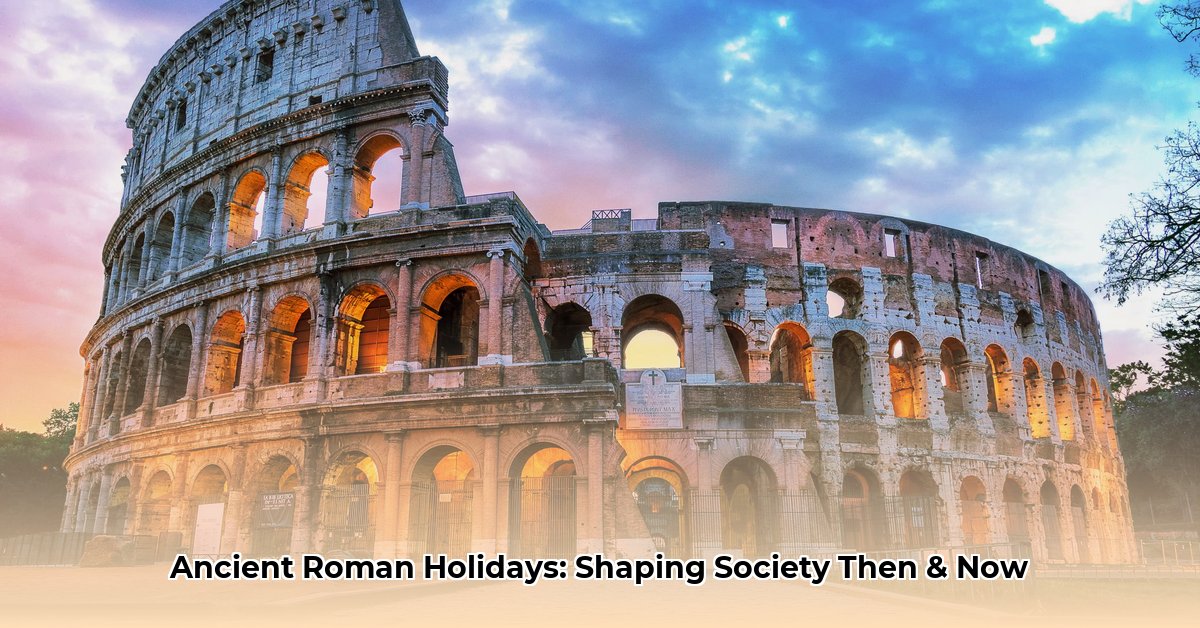Ancient Roman holidays were not merely days of leisure; they were the very bedrock of Roman society, profoundly influencing its morals, governance, and communal identity. From grand state-funded spectacles to intimate family gatherings, these celebrations provided the essential rhythm of life, honoring deities, marking agricultural cycles, and reinforcing social cohesion. Understanding these complex traditions is key to grasping the core values that shaped one of history's most enduring empires.
* Ancient Roman holidays were central to societal structure, ethics, and governance, encompassing both public (*feriae publicae*) and private (*feriae privatae*) celebrations.
* These festivals were critical for maintaining *pax deorum* (peace with the gods) and reinforcing civic unity through elaborate rituals, games (*ludi*), and community feasts.
* While many traditional Roman observances were transformed or replaced by Christianity, their underlying themes and customs continue to influence modern celebrations and cultural practices.
# The Unveiled Heartbeat of Rome: Ancient Festivals and Their Profound Impact
Were **ancient Roman holidays** simply "days off" as we understand them today? Absolutely not. They were the pulsating heart of Roman existence, intricately woven into their moral fabric, the structure of their society, and the very machinery of their governance. Imagine them as comprehensive civic events: elaborate state-sponsored *feriae publicae* (public holidays) and more intimate *feriae privatae* (private family gatherings). These special days provided the year's fundamental rhythm, marking crucial agricultural moments, venerating a pantheon of gods and goddesses, and strengthening the social bonds that held Rome together.
### The Purpose and Types of Roman Festivals
The Roman state invested significant resources—time, effort, and public funding—into *feriae publicae*. These grand events often involved intricate ceremonies, including animal sacrifices and thrilling public games (*ludi*). The primary motivation was to appease the gods and maintain *pax deorum* (the peace of the gods), a divine favor considered absolutely essential for Rome's prosperity and security. The Romans believed that a harmonious relationship with their deities guaranteed success.
However, Roman religious life extended beyond monumental public displays. Families meticulously observed *feriae privatae*, honoring deceased relatives and the household gods (*Lares* and *Penates*) who safeguarded their homes. These private observances were crucial for reinforcing familial piety, lineage, and tradition.
Roman public holidays were broadly categorized into three types:
* ***Stativae:*** Annual holidays with fixed dates on the calendar, like the *Lupercalia* or *Saturnalia*.
* ***Conceptivae:*** Annual holidays with moveable dates, announced by magistrates or priests, similar to modern Easter. The *Compitalia*, for instance, was a significant *feriae conceptivae* whose date varied.
* ***Imperativae:*** Holidays held "on demand" due to extraordinary circumstances, such as severe omens or to offer expiation for perceived divine displeasure. Livy recounts instances where a nine-day festival was ordered in response to reported stone showers, indicating divine displeasure.
On these *feriae*, public business was suspended. Varro defined *feriae* as "days instituted for the sake of the gods," implying that all earthly concerns should cede to divine reverence. Even slaves were granted a form of rest, and free citizens were expected to refrain from lawsuits and quarrels. While some vital agricultural tasks were permissible if an expiatory sacrifice (a *piaculum*, often a puppy or a pig) was made in advance, high-ranking priests like the *Flamens* and the *Rex Sacrorum* were forbidden even from witnessing work.
### The Roman Calendar's Precise Rhythm
The **Roman calendar** was structured around specific, recurring dates that dictated the flow of life:
* **The Kalends:** Always the first day of each month, sacred to Juno. The *Regina Sacrorum*, a public priestess, marked the day with a sacrifice to the goddess. The word "calendar" itself derives from "Kalends."
* **The Nones:** The 5th or 7th day of the month, depending on its length. On this day, announcements were made regarding events for the month ahead.
* **The Ides:** Usually the 13th, or the 15th in a few months (March, May, July, October). The Ides were sacred to Jupiter, and a white lamb was ritually sacrificed to him on the Capitolium.
These key dates were not arbitrary; they intricately linked daily life with religious observances, scheduling legal matters and governmental meetings around the sacred rhythm of the month.
### A Journey Through Rome's Diverse Festivals
The Roman year was a vibrant tapestry of festivals, each with unique rituals and significance.
#### January: Beginnings and Gateways
* **Agonalia (January 9):** Dedicated to Janus, the god of beginnings, gates, and doorways. This festival, where a ram was often sacrificed, marked the symbolic opening of the year and sought protection for the city's thresholds. Janus, often depicted with two faces looking backward and forward, perfectly embodied transitions.
* **Carmentalia (January 11-15):** Honoring Carmentis, a prophetess and goddess of childbirth, this festival was primarily observed by women and sought blessings for new life.
* **Compitalia (Late December/Early January, moveable):** One of the most important *feriae conceptivae*, celebrating the *Lares Compitales*, crossroads deities. In the countryside, landowners would build shrines at boundaries and sacrifice to purify the farm for the coming year. Slaves were often given extra rations and even dined with their masters' foremen, sharing characteristics with Saturnalia.
For more on the lighter side, see [entertainment in Rome](https://www.lolaapp.com/entertainment-in-ancient-rome).
#### February: Purification and Ancestry
* **Parentalia (February 13-21):** A nine-day period of solemn remembrance for deceased family members. Romans would visit cemeteries, placing offerings of flowers, milk, and wine on graves, often engaging in quiet contemplation. The *Caristia* on the 22nd followed, a joyous family reunion for the living, patching up quarrels and sharing a meal. This practice may have influenced the Christian "novena."
* **Lupercalia (February 15):** A wild fertility festival, originating from the cave of Lupercal where Romulus and Remus were supposedly reared by a wolf. Priests, known as *Luperci*, clad in goatskins, would run through the city, gently striking onlookers with strips of goat hide (*februa*, "means of purification"). Women desiring to conceive a male heir would deliberately seek this touch.
* **Quirinalia (February 17):** Honoring Quirinus, an ancient Sabine war god later identified with Romulus.
* **Fornacalia (February 17):** A baking festival dedicated to Fornax, goddess of the oven, ensuring successful bread production.
* **Feralia (February 21):** Another day for honoring the dead, particularly ancestors, to prevent their restless spirits from troubling the living. Marriages were prohibited, temples closed, and Ovid describes an old woman performing a ritual with beans and a fish to gag "spiteful tongues."
* **Terminalia (February 23):** Dedicated to Terminus, god of boundaries, where farmers would meet neighbors at their land borders to affirm boundaries and make small offerings.
#### March: The Month of Mars
* **Equirria (March 14):** Chariot races on the Campus Martius in honor of Mars, aimed at purifying the army and boosting morale before military campaigns.
* **Liberalia (March 17):** To Liber and Libera, celebrating freedom. This was also the day when boys transitioned to adulthood, donning the *toga virilis* (manly gown) around their sixteenth birthday.
* **Quinquatrus (March 19):** To Mars and Minerva, observed by students, teachers, doctors, and artisans.
* **Tubilustrium (March 23):** To Mars, for cleaning war trumpets to ensure success in upcoming campaigns.
#### April: Harvest and Regeneration
* **Ludi Megalenses (April 4-10):** Honoring Cybele, the Great Mother, whose sacred stone was brought to Rome in 204 BC. These games often featured chariot racing and theatrical performances.
* **Ludi Ceriales (April 12-19):** Dedicated to Ceres, goddess of the harvest. A peculiar feature was the release of foxes with lit torches tied to their tails, possibly to avert danger to crops.
* **Parilia (April 21):** Originally a rural festival for purifying sheep, later commemorating the founding of Rome ("Rome's birthday"). Festivities included bonfires and outdoor feasts.
* **Vinalia Urbana (April 23):** To Jupiter and Venus, where the previous year's vintage was sampled, and offerings were made to ensure a good wine harvest.
* **Robigalia (April 25):** To Robigus, who personified agricultural disease. A puppy was sacrificed to protect grain fields from blight.
* **Ludi Floriales (April 28 - May 3):** To Flora, goddess of flowers and fertility. Known for their licentious nature, including strip-tease performances by prostitutes, which Cato the Younger famously refused to watch.
#### May: Spirits and Growth
* **Lemuria (May 9, 11, 13):** Days when the restless ghosts of the dead were believed to roam. Household heads would walk barefoot at midnight, throwing black beans over their shoulder to appease the spirits, while other family members clashed metal pots to drive them away.
* **Mercuralia (May 15):** In honor of Mercury, god of commerce and travelers, merchants sprinkled water on themselves and their goods for successful trade.
* **Ambarvalia (Moveable, May):** A rural purification festival involving processions and sacrifices to Ceres to ensure a good harvest.
#### June to August: Summer Celebrations
* **Vestalia (June 9):** To Vesta, goddess of the hearth and home. Married women brought gifts to her temple, and it was a holiday for bakers.
* **Ludi Apollinares (July 6-13):** Instituted in 212 BC after prophecies and a plague, these games honored Apollo and became a regular calendar event, often featuring chariot races.
* **Neptunalia (July 23):** To Neptune, god of the sea. Bargemen and dock workers celebrated by building huts from branches and leaves, feasting and drinking in the summer heat.
* **Volcanalia (August 23):** To Vulcan, god of life-sustaining fire. Celebrated to prevent destructive fires, paradoxically by making bonfires and throwing live fish or small animals into them as symbolic offerings.
#### September to December: Harvest, Triumph, and Winter Merriment
* **Ludi Romani (September 5-19):** Originally vowed by generals for victory, these "Great Games" became widely popular. They involved theatrical performances and chariot races, but initially *not* gladiatorial combat, which was part of *Munera* (Etruscan funerary rites).
* **Augustalia (October 12):** Instituted in Augustus's honor in 19 BCE, celebrating his return from settling eastern provinces and symbolizing peace and military success.
* **Equus October (October 15):** A chariot race in honor of Mars, where the right-hand winning horse was sacrificed. Its tail was carried to the Regia, and its head became a contested prize between residents of the rich Via Sacra and the poorer Subura districts.
* **Armilustrium (October 19):** Marked the end of the military campaigning season, with weapons ritually purified and stored.
* **Ludi Plebeian (November 4-17):** "Plebeian Games," second only to the *Ludi Romani* in importance.
* **Saturnalia (December 17, extending to 7 days by late Empire):** The most famous and beloved **Roman festival**, a midwinter celebration of the solstice and Saturn, god of agriculture and time. It was a period of unrestrained merriment, social inversion where masters served their slaves, temporary immunity from punishment, gambling, gift-giving (small clay figures called *sigillaria*, candles), and widespread feasting. A "Saturnalian King" was chosen by dice, whose absurd commands had to be obeyed. Laurel boughs, greenery, and candles decorated homes. Its deep roots are thought to extend to ancient Mesopotamian traditions celebrating the chief god Marduk's annual struggle against chaos, and it profoundly influenced the development of modern Christmas traditions.
### Beyond Fixed Dates: Imperative Festivals and Commerce
Beyond the regular calendar, Rome also observed *feriae imperativae*, called "on demand" for special purposes. The **Secular Games** (*Ludi Saeculares*) were an irregular but monumental example, intended to be held once a century to mark the beginning of a new age, offering grand spectacles and sacrifices. Amazingly, at one point, two cycles of these games were being held simultaneously.
Additionally, *mercatus* (fairs or markets) were often held immediately after *ludi*. Cicero noted that Numa Pompilius, Rome's semi-legendary second king, established these fairs in conjunction with religious festivals to facilitate trade when large crowds had already gathered. By the late Republic, these became specialized retail fairs, like the *Sigillaria* attached to the Saturnalia, where gifts were purchased. The English word "fair" itself derives from Latin *feria*.
### The Enduring Legacy: Rome's Echoes in Modern Celebrations
The 4th century CE saw the gradual rise of Christianity, which significantly transformed or replaced many **Roman religious festivals**. Yet, the essence of these ancient celebrations lives on. The **Saturnalia**, with its themes of gift-giving, feasting, and general revelry, directly influenced the development of **Christmas** celebrations. The **Lupercalia**, a fertility festival, is often seen as an ancient precursor to **Valentine's Day**.
The focus on community engagement, spectacular public displays, and feasting—whether for religious or social purposes—continues to resonate in contemporary festivals and cultural practices worldwide. From carnivals that echo the spirit of social inversion to the simple act of gift-giving, understanding **ancient Roman holidays** provides invaluable insight into the enduring power of tradition and their profound, lasting influence on Western civilization. The **Roman accomplishments** were not just in engineering or law, but in shaping the very way we celebrate life and connect with each other.










